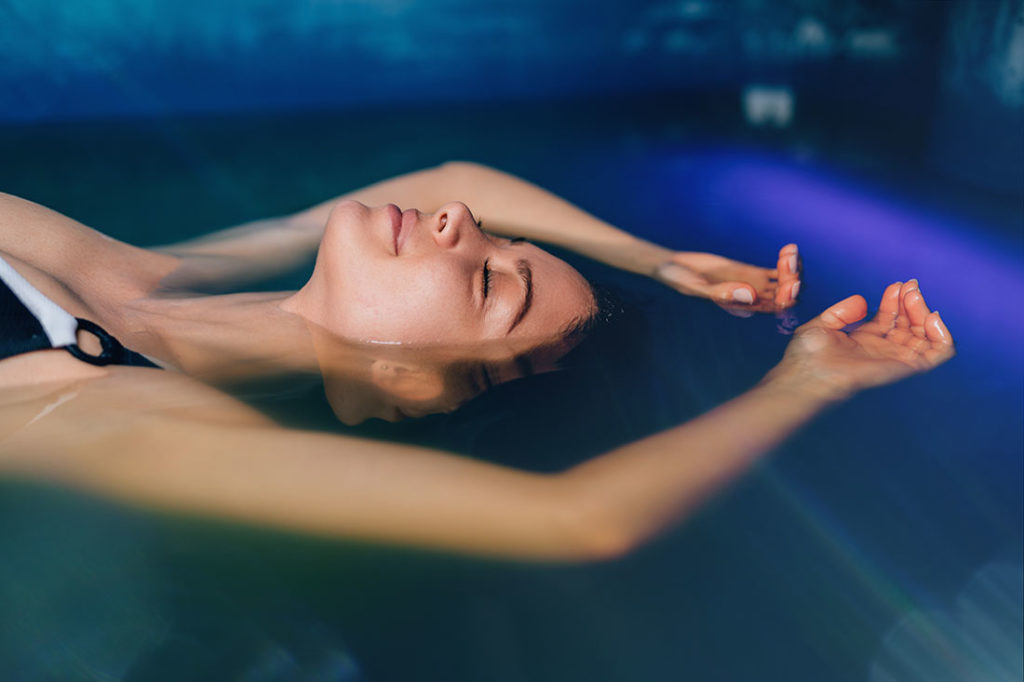The first time I did it I nearly had a panic attack.
The second time I felt profoundly calm.
The third time I stepped into a chamber smaller than the average prison cell and floated naked in 250 gallons of salt-saturated water, I experienced an insight that was pretty close to life-changing.
I hadn’t expected an epiphany when I signed up for my first floating experience. Alternately called float or flotation therapy and sensory deprivation or isolation tanks, these pitch-black, soundproof pods date back to the 1950s. Neuroscientist John C. Lilly was the first to develop the sensory deprivation tanks, though his original purpose for them was somewhat different. He would reportedly take a dose or two of LSD before floating in an attempt to “explore alternate realities.”
Float tanks became available to the public in the 1970s, and enjoyed a boom in the ’70s and ’80s before pretty much vanishing for a time. Now, however, they are back and more popular than ever. You can find float centers from Miami to Menomonee Falls, Wisconsin, from San Francisco to Sioux Falls, South Dakota, and New York to Nashville, Tennessee.
Floating gravity-free in complete darkness and silence provides a host of putative health benefits, including joint-pain relief and decreased blood pressure. But the promise of mindfulness is what attracts most floaters. While suspended in the saltwater solution, you achieve a state of relaxation that shifts your brain waves to the low-frequency theta state in which you experience a rarified sense of clarity, spirituality and oneness with the universe.
My goals were much less high-minded. I was driven by curiosity. If I expanded my consciousness in the void, so much the better.
A little online research quieted my qualms about whether the tanks were sanitary. The water’s high salinity means that no life form, including microbes and other pathogens, can survive. What’s more, between floats, the water in the tanks is circulated multiple times and treated with hydrogen peroxide and/or ozone and/or UV light, depending on the facility.
That left my second concern: claustrophobia.
While I don’t have a full-blown fear of confined spaces, my heart has on occasion raced when I’ve been wedged into center seats in packed theaters. But part of why I wanted to experience the float tank was to step outside—or, in this case, float outside—my comfort zone. Tolerating a little uneasiness wouldn’t be an altogether bad thing.
I booked my first float at Float Lab in Westwood, near the University of California, Los Angeles. Its floats last two hours and cost about $40, which is longer and cheaper than most places. Before you can reserve your session, you have to agree to a release form. Among other terms, I had to confirm that “I understand that it is not possible to predict every situation in which I will or will not mentally release…”
Although I wasn’t certain whether mentally releasing was something to be pursued or avoided, I e-checked my consent. Three days later I opened the door to Float Lab’s bunkerlike office suite and was greeted by Crash. With his dark glasses, shaggy hair and loopy demeanor, Crash, who owns this facility and another one in Venice Beach, looked as if he had just stepped out of The Big Lebowski.
Crash told me and the half-dozen other clients waiting for our appointments that at the end of the two-hour session, we’d hear knocking at the back of the tank. That was our signal to slowly get up and take our second shower (you take the first before the float).
We were led down a hallway to our private floating rooms. Inside each was a small dressing area with a shower and amenities such as earplugs and petroleum jelly for covering any cuts so the saltwater wouldn’t sting. After showering, I grabbed the heavy handle to the floating chamber—the kind you’d find outside a meat locker—and stepped inside. The warm water was about 10 inches deep. As instructed, I sat down, closed the chamber door, reclined and then pressed the button on the side of the tank to turn off the lights.
Here was the shock: The chamber measured 5 feet wide, 8 feet long and 7 feet high, but it felt vast. I stretched my hands over my head and circled them down to my sides. As I did, my body rotated slightly. I realized how easy it would be to become disoriented. How would I find the door in the pitch-blackness if I wanted to leave before the two hours were over and the lights came back up? That’s when I experienced the beginnings of panic. I sat up, groped for the door handle and opened the door a little to admit a sliver of dressing-room light.
For a while I kept the door cracked. I listened to my heartbeat, which echoed loudly in the silence. I meditated, following the movement of my breath. I got bored; then I got giddy; then I got bored again; then I actually laughed out loud. I intoned a couple of affirmations about loving-kindness.
I relaxed enough to close the door completely after about an hour. Then I started thinking about what to cook for dinner and where to shop for the salmon and kale I decided to make. The more I thought about this, the hungrier I became. Finally, I got up slowly, opened the door, looked at the clock on the wall, and saw that I’d been in the tank for an hour and 20 minutes.
When I left a few minutes later, my legs felt heavy, but my spirits were light. I was eager to float again.
For my second float, I chose Just Float in Pasadena. With 11 float rooms, it calls itself “the world’s largest float therapy spa.” The vibe is zen, with soothing ocean-blue walls in undulating wavelike patterns and a post-float lounge to enjoy herbal tea.
The sessions at Just Float last one hour, which is pretty standard; the first float is $30 and subsequent ones are $60. When you first enter the floating cabin, it’s illuminated and soft orchestral music is playing. The lights and music fade after a few minutes. At the end of the float, three chimes sound and the lights come back on.
These small differences from Float Lab helped me relax big-time. Freed from calibrating my level of anxiety, I observed how there was no clear demarcation between where my body ended and the water began, and that amid the darkness there were little starbursts of color. My meditation was deeper this time. I spent a few moments silently expressing gratitude. I was bursting with abundant emptiness and serenity.
—
“You could consider the float tank a think tank and go in there and ask your higher self for a solution to whatever’s troubling you.”
—
But I wanted to wring more from floating, so I reached out to Paulette Sherman, Psy.D. She’s a New York City psychotherapist and author of several books, including her most recent, Marriage and the Law of Attraction: The Secret to Creating Your Perfect Relationship, which was published in 2020.
“You have great access to your higher self when you float,” Sherman said. “You could consider the float tank a think tank and go in there and ask your higher self for a solution to whatever’s troubling you.”
Bingo!
During my third float, back at Just Float, I set about appealing to my higher self. What can I do to be more productive? I asked. My higher self suggested that my output might improve if I spent less time bobbing like a champagne cork in salty water. But that snarky voice soon grew quiet, replaced by a more loving inner dialogue.
What made the experience of floating so restorative? I asked myself.
It’s the feeling of being supported effortlessly.
How can I duplicate that feeling when it comes to my work?
Effortlessness isn’t realistic. Writing is difficult. But maybe there’s a way you can achieve ease.
I breathed deeply as I pursued this line of thought.
I always find ease in cooking when I practice what professional kitchens call mise en place. The French term means having all your ingredients and tools organized or “put in place” before you begin to cook. It’s a practice that allows me to move through the steps of preparing a meal without wasting effort.
I wanted to bring mise en place to my work.
Then I thought about the times when I felt immersed in an activity, whether it was walking my dog, reading a novel or having a deep conversation with a friend. That happened when I wasn’t distracted, when I left my smartphone at home, turned off the TV, stopped turning around to see who was walking through the door of the restaurant.
I came up with a list of other elements that led to full task engagement. They included thought (considering how I wanted to structure an article or even a task like reorganizing a closet, before I dove in willy-nilly), energy (getting enough sleep so I was well-rested) and economy (budgeting the right amount of time for tasks).
When I got home, I typed the list, printed it in a 24-point font and hung it on my office bulletin board.
- Ease
- Mise en place
- Distraction-free
- Thought
- Energy
- Economy
This list probably won’t be meaningful to anyone else, but those words immediately guided me to make needed changes in my work habits. Now, before I write, I assemble all my research material in clearly labeled folders, I shut down my email and browser, and I set a pitcher of jasmine tea and a glass on one corner of the desk. I also decide in advance how often I’ll log in to check my email inbox (usually every hour) as well as when and how long my breaks will be.
Since I’ve implemented these changes, I feel more intentional about how I spend my time and efforts.
When I find myself drifting back to dis-ease, which I expect will happen eventually, I’ll book another float.
This article was published in May 2016 and has been updated. Photo by hedgehog94/Shutterstock









